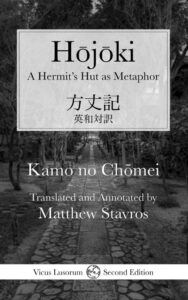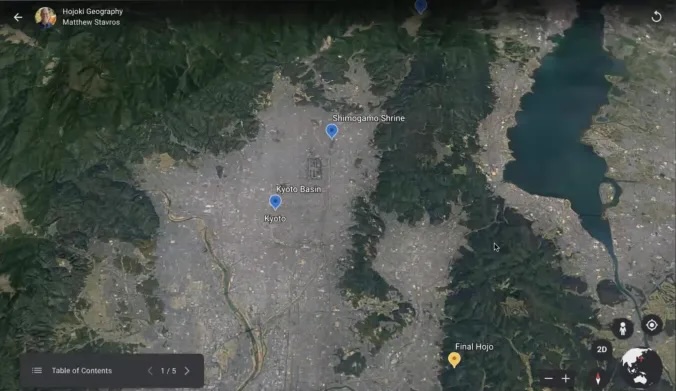Hōjōki: seeking solace in the time of COVID
A report on the Zoom talk by Matthew Stavros (Nov 27, 2020)
“The best way to understand the world today, is to hold up a mirror to the past.” Kamo no Chōmei (1155-1216 AD) wrote these prescient words in Hōjōki, the celebrated memoir of his retreat from late 12th/early 13th century Kyoto to a ten-foot square hut (hōjō) in the eastern mountains of the city.
Chōmei completed his poetic and poignant observations about the human condition in 1213 AD. For centuries people have been drawn to his insights, especially in calamitous times. In early 2020 it was the outbreak of COVID-19 that inspired Matthew Stavros to translate Hōjōki. Like Chōmei, he was seeking solace in a troubled world full of natural disasters and political strife.
Matthew shared his experiences translating Hōjōki during a Zoom event organised by Writers in Kyoto (WiK) on November 27th, 2020. Because of the online format, I was able to join the presentation and discussion from Australia. It was uplifting to see so many familiar faces. This précis of Matthew’s insights is for those who were unable to attend.
‘Hōjōki: A Hermit’s Hut as Metaphor’ is the title Matthew chose for his annotated and illustrated translation. The text is presented in eiwa taiyaku style, with the English and original Classical Japanese presented side by side. The Zoom format suited the sharing of maps depicting the time of Hōjōki and related images from Matthew’s book. They were drawn from the second edition of the book and helped place Chōmei’s story in context.

To increase the reach of Hōjōki, Matthew is creating an audio book narrated by MG Miller from Anchorage, Alaska. The Prologue and two chapters we heard during the presentation were sonorous and soothing. This alternative sensory format should appeal to many.
Hōjōki’s famous Prologue highlights the transitory nature of life, likening people’s existence to bubbles on water and dew on a morning glory; it begins with….
The flow of the river never ceases,
And the water never stays the same.
The impermanence of the world is a thread that weaves its way through Hōjōki. Three other Buddhist themes are used to group the 14 short chapters in Matthew’s translation: Suffering, Detachment and Transcendence.
The first five chapters introduce the major fire, whirlwind, moving of the capital, famine and earthquake that occurred in succession in Kyoto between 1177 and 1185 AD. Matthew described a clear, anthropocosmic relationship between the natural world and the world of man at that time, one that contrasts with the current Anthropocene. (The world population when Hōjōki was written is estimated at around 400 million people. Nearly 8 billion (8000 million) people now live on Earth. Our impact is immense and global.)
Kyoto has suffered many ‘natural’ disasters over its long history. As the author of a book and several academic papers on Kyoto’s architectural and urban history, Matthew knows this well. His comment that Kyoto was defined by fire caught my attention. Large parts of the city have burnt down and been rebuilt many times, influencing both the architecture and mindset of residents.
In the period that Chōmei was writing, Matthew noted a lack of political will to address the impact of the many disasters besetting Kyoto. Mark Schumacher also pointed out that it was the beginning of the age of Mappo, the belief that Buddha’s law was in a state of degeneration. It was a time of great social upheaval and throwing out of the old. Kyoto in the late 12th century was indeed a troubled place. The time of Hōjōki and the time of COVID have much in common, hence the benefit of holding a mirror to the past. A thoughtful thought experiment was used in the presentation to highlight the similarities.
So how did Chōmei, who came from a privileged family, respond to a Kyoto that was far removed from the heyday of the Heian period? Reflecting on the state of the world and the dangers of attachment to people and possessions, he progressively withdrew from his life among the elite of Kyoto. He chose to retreat from the world, though as Matthew observed he had the means to do so and enjoyed a kind of safety net. Each time he moved his house became smaller, until it became the three square meters of his hōjō.
In his 50s Chōmei lived in Ohara north of Kyoto, possibly attracted there by the Tendai sub-temples. Then at 60 years of age he moved to Hino to live out his days. It was here that he put brush to paper to write Hōjōki, exhorting his readers not to cling to possessions, status, or social recognition. He used the hut as a metaphor for worldly attachment. Chōmei’s actions represented extreme social-distancing, although he did have a companion to walk with in the mountains, and help from others, from time to time.

Hōjōki is the most celebrated example of ‘recluse’ literature from medieval Japan. Chōmei romanticised isolation and letting go of the world, and eschewed attachments and possessions. Despite this he loved his small grass hut in Hino, a place where he played the lute and koto, prayed, and watched the seasons pass. Chōmei considered this attachment a weakness, referring to his dilemma in the ‘Transcendence’ chapters of Matthew’s translation. I find it ironic in a way that despite withdrawing from the world, Chōmei left an enduring legacy in the world through his essays and musings.

Personally I wouldn’t follow in Chōmei’s footsteps and become a recluse. Humans are social animals after-all. The main messages I took from Matthew’s translation of Hōjōki are the importance of: living simpler and self-reliant lives with much less ‘stuff’; slowing down and taking time to get to know, respect and rely on your inner-self; ‘being’ in the present; and, finding pleasure and beauty in nature and being sensitive to our impacts. With global climate change, natural disasters will become more frequent, intense and affect larger areas. It is reassuring to know that, at a smaller scale, humanity has faced and survived times of great upheaval before.
Matthew’s presentation was erudite and thought-provoking. His translation is a labour of love. He hopes that the messages in Hōjōki will help people maintain perspective even during extraordinarily challenging times. Rather than feeling ‘we’re screwed’ Chōmei’s writings encourages readers to take a deep breath, centre themselves and to remember that like the flow of the river, this too shall pass. These are lessons we can all learn from.
*****
The replica of Chōmei’s small hut is located in Kawai Shrine, in the grounds of Shimogamo Jinja in Kyoto. Chōmei’s family was attached to Shimogamo, a prestigious institution that pre-dates the founding of Kyoto. The fact that he was passed over for the position of Head Priest contributed to his decision to take leave of the world and become a recluse.
Matthew Stavros is a historian of Japan at the University of Sydney and former director of the Kyoto Consortium for Japanese Studies. He is the author of Kyoto: An Urban History of Japan’s Premodern Capital (University of Hawai’i Press, 2014) and over a dozen academic articles on Kyoto’s architectural and urban history.
To learn more about Matthew’s translation of Hōjōki see www.kyotohistory.com.
